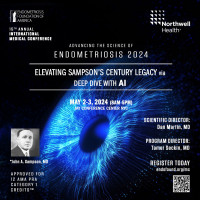
The recent controversy surrounding the United States Food and Drug Administration's approval of mifepristone has created tension and debate. Mifepristone, a medicine that blocks progesterone and is commonly associated with abortion, is also a treatment option for many other medical conditions, including endometriosis. The attack on mifepristone may have far-reaching implications for patients and physicians alike, limiting the availability of medication for those who may benefit from it.
The Endometriosis Foundation of America, or EndoFound, recognizes the potential importance of mifepristone as a treatment option for their patients, as well as for individuals receiving care from internists, family physicians, general obstetricians, high-risk obstetricians, infertility specialists, gynecologists, and oncologists. Treated diseases include, but are not limited to, Cushing Syndrome, infertility, estrogen-free contraception, heavy uterine bleeding, anemia, inducing labor in term pregnancy, ectopic pregnancy, intrauterine surgery, fibroids, endometriosis, adenomyosis, miscarriages, insulin sensitivity in obesity, breast cancer, ovarian cancer, prostatic cancer, melanoma, meningioma, and several psychiatric disorders.
An annotated bibliography with citation links is available.
The organization is not interested in entering the abortion debate, but rather in protecting the availability of a medication that helps patients who suffer from endometriosis and other conditions.
It's important to acknowledge that the abortion debate has become a highly charged and emotional topic, and both sides of the issue are deeply committed to their positions. However, it's equally essential to recognize that mifepristone is not solely associated with abortion. This medication has a broad range of medical applications, and its availability should be preserved for those who need it.
The politicization of medicine is a concerning issue that affects the well-being of individuals and society as a whole. Mifepristone can treat or facilitate the treatment of a multitude of health conditions and medical procedures other than abortions. We must resist attacks on medicine solely because of its potential use in controversial procedures. The politicization of medicine undermines its scientific integrity and can harm those in need of medical care. As responsible individuals, we should work toward promoting evidence-based medicine that prioritizes patient welfare above political agendas. We hope that you share this perspective and will join us in advocating for unbiased, patient-centered medical care.
The Endometriosis Foundation of America urges states, courts, and Congress to preserve access to mifepristone for sufferers of endometriosis and other conditions. By doing so, we can ensure that patients have access to the full range of treatment options and that physicians are able to provide the best possible care to their patients. We must strive to present a nuanced perspective that acknowledges the complexity of the issue while understanding the need for this medication outside of the abortion arena.
Thank you for reading our message and continuing to support EndoFound's mission.
Mifepristone Bibliography
Dan C. Martin, MD
= = = = PubMed and Google Scholar = = = =
PubMed has 77 papers on mifepristone and infertility, and 1,139 on mifepristone and cancer.
https://pubmed.ncbi.nlm.nih.gov/?term=mifepristone+infertility&sort=date
https://pubmed.ncbi.nlm.nih.gov/?term=mifepristone+cancer&sort=date
Google Scholar has 7,600 papers, abstracts, and patents on mifepristone and infertility, and 21,200 on mifepristone and cancer.
https://scholar.google.com/scholar?as_sdt=7%2C47&q=mifepristone+infertility&hl=en&inst=10 63551842422345302
https://scholar.google.com/scholar?as_sdt=7%2C47&q=mifepristone+cancer&hl=en&inst=1063 551842422345302
= = = = Reference Summary = = = =
Review Article
- Karena 2022 mifepristone review C This contains most of the other material. Read its summary first.
Cushing's syndrome
- Karena 2022 mifepristone review C
- Silverman 2022 Cushing Syndrome AACECCR
Cancer
- Karena 2022 mifepristone review C
- Check 2021 mifepristone model IJMS
- Check 2021 progesterone receptor modulators AR
- Check 2023 progesterone receptor in cancer EREM
- Hamza 2023 LPS-primed breast cancer IJMS
- Karena 2022 mifepristone review C
- Elía 2023 breast cancer CCR
- Klijn 1989 antiprogestins human breast cancer.
- Liu 2022 microRNA-378 signaling CDD
Anovulatory Infertility
- Karena 2022 mifepristone review C
- Jeon 2023 Cortisol/glucocorticoid receptor HR
Miscarriage
- Karena 2022 mifepristone review C
- Esposito 2023 early pregnancy loss FSR
Fibroids
- Karena 2022 mifepristone review C
- Park 2022 leiomyoma IJMS
Progression of pancreatic cancer on glucocorticoids:
- Liu 2022 progression of pancreatic cancer CDD
= = = = Alphabetized References = = = =
Check 2021 mifepristone model IJMS
Check JH, Check DL. A hypothetical model suggesting some possible ways that the progesterone receptor may be involved in cancer proliferation. Int J Mol Sci. 2021 Nov 16;22(22):12351. doi: 10.3390/ijms222212351. PMID: 34830233; PMCID: PMC8621132.
Open Access: https://www.mdpi.com/1422-0067/22/22/12351
PMC Open Access: https://www.ncbi.nlm.nih.gov/pmc/articles/PMC8621132/
DCM Summary:
Theoretical concerns and anecdotal evidence on mifepristone in some cancers can improve longevity and quality of life.
Cancer and the fetal-placental semi-allograft share certain characteristics, e.g., rapid proliferation, the capacity to invade normal tissue, and, related to the presence of antigens foreign to the host, the need to evade immune surveillance. Many present-day methods to treat cancer use drugs that can block a key molecule that is important for one or more of these characteristics and thus reduce side effects. The ideal molecule would be one that is essential for both the survival of the fetus and malignant tumor, but not needed for normal cells. There is a potentially suitable candidate, the progesterone-induced blocking factor (PIBF). The parent 90 kilodaltons (kDa) form seems to be required for cell-cycle regulation, required by both the fetal placental unit and malignant tumors. The parent form may be converted to splice variants that help both the fetus and tumors escape immune surveillance, especially in the fetal and tumor microenvironment. Evidence suggests that membrane progesterone receptors are involved in PIBF production, and indeed there has been anecdotal evidence that progesterone receptor antagonists, e.g., mifepristone, can significantly improve longevity and quality of life, with few side effects
Check 2021 progesterone receptor modulators AR
Check JH, Check D. New insights as to why progesterone receptor modulators, such as mifepristone, seem to be more effective in treating cancers that are devoid of the classical nuclear progesterone receptor. Anticancer Res. 2021 Dec;41(12):5873-5880. doi: 10.21873/anticanres.15407. PMID: 34848442.
Open Access: https://ar.iiarjournals.org/content/41/12/5873.long
DCM Summary: Mifepristone for advanced cancer demonstrates improvement in length and quality of life in patients who have no other treatment options.
Mifepristone treatment for advanced cancer has demonstrated considerable improvement in both length and quality of life in patients who no longer have any other treatment options. The target is the progesterone induced blocking factor (PIBF), which helps the tumor to invade the normal tissue and proliferate and suppress cellular immunity. Most of the benefit has been observed in cancers not associated with the classical nuclear progesterone receptor (nPR). There are data showing that the presence of a nPR may be associated with a better prognosis. Membrane PRs seem to be responsible for PIBF secretion. Mifepristone, possibly fails to block another P associated protein that enables the tumor to proliferate, e.g., the progesterone receptor membrane component-1 (PGRMC-1) protein. One hypothesis is that the nPR helps to inhibit tumor production of PGRMC-1 protein. Thus, mifepristone may inhibit tumor spread by suppressing PIBF, but this may be negated by blocking the nPR, allowing PGRMC-1 levels to increase
Check 2023 progesterone receptor in cancer EREM
Check JH, Check DL. The role of progesterone and the progesterone receptor in cancer: progress in the last 5 years. Expert Rev Endocrinol Metab. 2023 Jan;18(1):5-18. doi: 10.1080/17446651.2023.2166487. Epub 2023 Jan 16. PMID: 36647582.
$95 at
https://www.tandfonline.com/doi/abs/10.1080/17446651.2023.2166487?journalCode=iere20
DCM Summary: Mifepristone increases the quality and length of life in cancers with no nuclear progesterone receptors.
Patients with various advanced cancers devoid of nuclear progesterone receptors (nPR) have demonstrated increased quality and length of life when treated with the PR modulator mifepristone, which likely works by interacting with membrane PRs (mPR). The marked clinical improvement following 200–300 mg of mifepristone is likely related to blocking PIBF. In the low dosage used, mifepristone likely acts as an agonist for PGRMC-1 protein. Mifepristone may be less effective for cancers positive for the nPR because the nPR may be protective and blocking it may have detrimental effects. Based on this hypothetical model, the development of other potential treatment options to provide even greater efficacy for treating cancer is discussed.
Elía 2023 breast cancer CCR
Elía A, Saldain L, Vanzulli SI, Helguero LA, Lamb CA, Fabris V, Pataccini G, Martínez-Vazquez P, Burruchaga J, Caillet-Bois I, Spengler E, Acosta Haab G, Liguori M, Castets A, Lovisi S, Abascal MF, Novaro V, Sánchez J, Muñoz J, Belizán JM, Abba MC, Gass H, Rojas P, Lanari C. Beneficial effects of mifepristone treatment in patients with breast cancer selected by the progesterone receptor isoform ratio: Results from the MIPRA trial. Clin Cancer Res. 2023 Mar 1;29(5):866-877. doi: 10.1158/1078-0432.CCR-22-2060. PMID: 36269797; PMCID: PMC9975668.
PMC Open Access: https://www.ncbi.nlm.nih.gov/pmc/articles/PMC9975668/
DCM summary: 14 of 20 patients with luminal breast cancer responded to mifepristone. Twenty patients with luminal breast carcinomas with PRA/PRB > 1.5 (determined by Western blots), and PR ≥ 50%, naïve from previous treatment, were included for mifepristone treatment (200 mg/day orally; 14 days).
A 49.62% decrease in Ki67 staining was observed in all surgical specimens compared with the baseline (P = 0.0003). Using the prespecified response parameter (30% relative reduction), we identified 14 of 20 responders. Mifepristone induced an increase in tumor-infiltrating lymphocytes; a decrease in hormone receptor and pSer118ER expression; and an increase in calregulin, p21, p15, and activated caspase 3 expressions. RNA-seq and proteomic studies identified downregulated pathways related to cell proliferation and upregulated pathways related to immune bioprocesses and extracellular matrix remodeling.
Our results support the use of mifepristone in patients with luminal breast cancer with high PRA/PRB ratios.
Esposito 2023 early pregnancy loss FSR
Esposito L, Kornfield MS, Rubin E, O'Leary T, Amato P, Lee D, Wu D, Krieg S, Parker PB. Mifepristone-misoprostol combination treatment for early pregnancy loss after embryo transfer: a case series. F S Rep. 2023 Jan 20;4(1):93-97. doi: 10.1016/j.xfre.2023.01.003. PMID: 36959956; PMCID: PMC10028465.
Open Access: https://www.fertstertreports.org/article/S2666-3341(23)00003-X/fulltext
PMC Open Access: https://www.ncbi.nlm.nih.gov/pmc/articles/PMC10028465/
DCM Summary: Evidence strongly supports the mifepristone-misoprostol combination for early pregnancy loss among pregnancies conceived without assisted reproductive technologies. Evidence strongly supports the use of mifepristone-misoprostol combination treatment for early pregnancy loss (EPL) among pregnancies conceived without assisted reproductive technologies. Mifepristone-misoprostol combination treatment appears to be a reasonable option for those with EPL after IVF-ET.
Hamza 2023 LPS-primed breast cancer IJMS
Hamza S, Garanina EE, Alsaadi M, Khaiboullina SF, Tezcan G. Blocking the hormone receptors modulates NLRP3 in LPS-primed breast cancer cells. Int J Mol Sci. 2023 Mar 2;24(5):4846. doi: 10.3390/ijms24054846. PMID: 36902278; PMCID: PMC10002867.
PMC Open Access: https://www.ncbi.nlm.nih.gov/pmc/articles/PMC10002867/
DCM summary: Mifepristone can be used in some breast cancer and ovarian cancer. Tamoxifen (Tx), mifepristone (mife), and trastuzumab (Tmab) were used to block ER-α, PR, and HER2, respectively, on inflammasome activation in LPS-primed MCF7 cells. Additionally, a progesterone receptor (PR) antagonist, mifepristone (mife), has been shown to inhibit the growth of ovarian cancer and BC cells with high PR expression [See Elía et al. 2023].
Jeon 2023 Cortisol/glucocorticoid receptor HR
Jeon H, Choi Y, Brännström M, Akin JW, Curry TE, Jo M. Cortisol/glucocorticoid receptor: a critical mediator of the ovulatory process and luteinization in human periovulatory follicles. Hum Reprod. 2023 Apr 3;38(4):671-685. doi: 10.1093/humrep/dead017. PMID: 36752644; PMCID: PMC10068287.
$52 at https://academic.oup.com/humrep/article-abstract/38/4/671/7031301
DCM Summary: This is an academic summary with an abstract that supports the role of receptor signaling. I need to read the whole paper to see if there are actionable clinical suggestions. Successful ovulation and luteinization are essential for female fertility. Women with dysregulated cortisol levels often suffer from anovulatory infertility. Deciphering the functional role of glucocorticoid receptor signaling in human periovulatory follicles enhances our knowledge of basic ovarian physiology and may provide therapeutic insights into treating infertility in women. The ovulatory hCG stimulation-induced glucocorticoid receptor signaling plays a crucial role in regulating steroidogenesis and ovulatory cascade in human periovulatory follicles.
Karena 2022 mifepristone review C
Karena ZV, Shah H, Vaghela H, Chauhan K, Desai PK, Chitalwala AR. Clinical utility of mifepristone: Apprising the expanding horizons. Cureus. 2022 Aug 23;14(8):e28318. doi: 10.7759/cureus.28318. PMID: 36158399; PMCID: PMC9499832.
PMC Open Access: https://www.ncbi.nlm.nih.gov/pmc/articles/PMC9499832/
DCM summary:
Mifepristone plus misoprostol has a higher success rate and is more cost-effective than misoprostol alone for miscarriages.
It is successful as an estrogen-free contraceptive pill.
Mifepristone is efficient in inducing labor in term pregnancy.
Mifepristone and methotrexate result in better outcomes of ectopic pregnancy than methotrexate alone.
Mifepristone demonstrates a significant regression in visible endometriotic lesions in follow-up laparoscopy and a decrease in clinical symptoms.
Mifepristone can effectively inhibit the emergence and development of adenomyosis, control breakthrough bleeding, and decrease anemia.
It can improve ovarian hyperstimulation with in vitro fertilization.
It is also used for cervical softening before hysteroscopy, induction of labor, cancer, and leiomyoma; those need further study.
Mifepristone is FDA-approved for Cushing syndrome to control hyperglycemia in patients who are not candidates for surgical treatment or have not achieved remission from surgery. Short-term use improves adipose and hepatic insulin sensitivity in obese individuals with hyperglycemia without hypercortisolism.
It is used in breast cancer, ovarian cancer, prostatic cancer, melanoma, and meningioma. It has been found beneficial in several psychiatric disorders, including psychotic depression, cognitive dysfunction in schizophrenia and bipolar disorder, alcohol and cocaine dependence, posttraumatic stress disorder, weight gain associated with the use of antipsychotic drugs such as olanzapine, and Alzheimer’s disease
While there are few side effects at low doses, a high dose can have adverse effects which require careful monitoring and patient care. Those effects include hypertension, hypotension, hyperkalemia, hypokalemia, hyponatremia, low cortisol levels, mineralocorticoid deficiency, maculopapular rash, endometrial thickening, vaginal bleeding, edema, hyperglycemia, low blood sugar levels, headache, fatigue, and secondary hypothyroidism.
= = = = Quotes from the Paper = = = =
It has been found beneficial in the treatment of psychotic depression, cognitive dysfunction in schizophrenia and bipolar disorder, alcohol and cocaine dependence [88,89], posttraumatic stress disorder, weight gain associated with the use of antipsychotic drugs such as olanzapine [90-92], and Alzheimer’s disease [93]
Owing to the anti-progestational activity of mifepristone, it is used as monotherapy for PR-positive benign central nervous system tumors, such as meningioma,
Estrogen receptor (ER)-negative breast cancer with glucocorticoid receptor (GR) overexpression is associated with poor prognosis. GR antagonist with chemotherapy (nab-paclitaxel dose of 100 mg/m2 plus mifepristone 300 mg) helps to manage the toxicity of the former [73]. Mifepristone suppresses triple-negative breast cancer (TNBC) cell growth by inhibiting KLF5 expression via
inducing miR-153. However, even at high doses, it has limited anticancer efficacy. To enhance anticancer activities, a targeted compound chain containing 17 compounds is being designed and synthesized by altering the sensitive metabolic region of mifepristone [74]. Genetic deletion of the PR or its blockade by mifepristone-like progesterone antagonists effectively suppresses the development of high-grade squamous carcinoma (HGSC) of the ovary and its peritoneal metastases. Mifepristone treatment has been found to improve the survival rate in mice with HGSC. Hence, in women carrying a deleterious mutation in the BRCA gene, mifepristone can have a potential role [75,76]. Glucocorticoid and androgen receptor antagonist combination, mifepristone, and enzalutamide are safe and well tolerated for metastatic castration-resistant prostate cancer, but they do not result in PSA progression-free survival (PFS), with radiographic PFS, and PSA response rate (RR) earlier to monotherapy with enzalutamide. The development of more specific GR antagonists combined with AR antagonists, potentially studied in an earlier disease state, should be explored [77].
Short-term mifepristone administration improves adipose and hepatic insulin sensitivity in obese individuals with hyperglycemia without hypercortisolism [72].
The major side effect of early abortion is gastrointestinal and is commonly related to prostaglandin analog; however, these are self-limiting.
High-dose and prolonged use of mifepristone in Cushing syndrome brings about a concern about the adverse effects which require good monitoring and patient care. Those include hypertension, hypotension, hyperkalemia, hypokalemia, hyponatremia, low cortisol levels, mineralocorticoid deficiency, maculopapular rash, endometrial thickening, vaginal bleeding, edema, hyperglycemia, low blood sugar levels, headache, fatigue, and secondary hypothyroidism. In any condition that requires prolonged high-dose treatment of mifepristone, these adverse effects should be kept in mind and necessary precautions should be taken. Mifepristone alone is approved as a therapy for Cushing syndrome to control hyperglycemia in patients who are not candidates for surgical treatment or have not achieved remission from surgery for oral once-a-day administration [6,68-70].
Ovarian Hyperstimulation in In Vitro Fertilization: A single dose of mifepristone administered during the preovulatory phase of the cycle delays the LH surge and postpones ovulation [65]. Low doses of mifepristone may correct precocious luteinization and restore endometrial receptivity.
In a study by John et al., a 50 mg dose of mifepristone administered every two weeks decreased the incidence of breakthrough bleeding (BTB) in new starters of depot medroxyprogesterone (DMPA). This effect may be attributed to the modulation of endometrial estrogen and progesterone receptors [61,62]. Mifepristone as pretreatment is effective in reducing the number of episodes and duration of intermenstrual bleeding/spotting in levonorgestrel-releasing intrauterine system (LNG-IUS) users, given at a dose of 100 mg every 30 days for three months. In a study with a 25 mg daily dosage of mifepristone, there was a significant reduction in bleeding and spotting days [63,64].
Mifepristone can effectively inhibit the emergence and development of adenomyosis, decrease the uterine volume and cancer antigen-125 (CA-125) concentration, and increases the hemoglobin concentration in serum for adenomyosis patients [58,59].
Although used for clinically for cervical softening for hysteroscopy, studies are not consistent or promising.
The use of mifepristone for induction of labor awaits Food and Drug Administration approval. Its role in endometriosis, ectopic pregnancy, and adenomyosis requires more intensive research. It may be useful in treatment for cancer and leiomyoma.
In a trial with a 25 mg dosage, there was a 49% reduction in tumor volume after three months in uterine leiomyoma [56]. Another study concluded that there is a 90% reduction in menstrual blood loss with both 10 and 25 mg of mifepristone for three months in fibroid patients. However, a 25 mg dose has a significantly greater reduction in the size of myoma than 10 mg with no endometrial atypia [55]. For patients who want to avoid surgery, at a young age, premenopausal patients, as well as an adjunct to surgery for size reduction, mifepristone is a good choice. However, the notable adverse effect was the development of benign endometrial hyperplasia due to prolonged unopposed estrogen milieu [57]. Mifepristone reduces BCL-2, decreases epidermal growth factor (EGF) expression in fibroids, and increases tumor necrosis factor (TNF) and androgen receptors [51]. A size reduction may be due to its direct effect on PRs. Following mifepristone treatment in leiomyoma, amenorrhoea ensues because of ovulation inhibition.
A combination of mifepristone and methotrexate results in better outcomes of ectopic pregnancy. A dose of 50 mg of mifepristone for six months demonstrates a significant regression in visible endometriotic lesions in follow-up laparoscopy and a decrease in clinical symptoms Mifepristone is efficient in inducing labor in term pregnancy.
Reports of the use of mifepristone in preoperative hysteroscopy patients for cervical dilatation are not consistent or promising [37-39].
Treatment with mifepristone plus misoprostol has a higher success rate and is more cost-effective than misoprostol alone in the management of missed miscarriages [16-18]. Estrogen-Free Contraceptive Pill: A 200 mg mifepristone tablet on the 16th day of the menstrual cycle as a monthly pill has been found to have a high success rate and better acceptance rate in educated females [35]. Once weekly administration with 25 mg of mifepristone is also a potentially effective method for regular contraception [36].
The use of mifepristone for induction of labor awaits Food and Drug Administration approval. Its anti-progesterone action on the menstrual cycle has a new dimension of use as a contraceptive, as well as use as a menstruation inductive agent. Its role in endometriosis, ectopic pregnancy, and adenomyosis requires more intensive research. Apoptotic action of mifepristone, interference of heterotypic cell adhesion to the basement membrane, cell migration, growth inhibition of various cancer cell lines, decreased epidermal growth factor expression, suppression of invasive and metastatic cancer potential, increase in tumor necrosis factor, downregulation of cyclin-dependent kinase 2, B-cell lymphoma 2, and Nuclear factor kappa B have opened its potential to be explored as anti-cancer treatment and its effects on leiomyoma.
Klijn 1989 antiprogestins human breast cancer CR
Klijn JG, de Jong FH, Bakker GH, Lamberts SW, Rodenburg CJ, Alexieva-Figusch J. Antiprogestins, a new form of endocrine therapy for human breast cancer. Cancer Res. 1989 Jun 1;49(11):2851-6. PMID: 2720645.
DCM summary: Early, 1989, study with one objective response, 6 instances of short-term stable disease, and 4 instances of progressive disease.
The antitumor, endocrine, hematological, biochemical, and side effects of chronic second-line treatment with the antiprogestin mifepristone (RU) 486) were investigated in 11 postmenopausal patients with metastatic breast cancer. We observed one objective response, 6 instances of short-term stable disease, and 4 instances of progressive disease.
Liu 2022 progression of pancreatic cancer CDD
Liu L, Han S, Xiao X, An X, Gladkich J, Hinz U, Hillmer S, Hoppe-Tichy T, Xu Y, Schaefer M, Strobel O, Herr I. Glucocorticoid-induced microRNA-378 signaling mediates the progression of pancreatic cancer by enhancing autophagy. Cell Death Dis. 2022 Dec 19;13(12):1052. doi: 10.1038/s41419-022-05503-3. PMID: 36535942; PMCID: PMC9763328.
PMC Open Access: https://www.ncbi.nlm.nih.gov/pmc/articles/PMC9763328/
DCM summary: Glucocorticoids may cause some cancer to worsen. The role of mifepristone is not clear. Controversially, glucocorticoids may also cause the progression of highly aggressive pancreatic ductal adenocarcinoma.
Park 2022 leiomyoma IJMS
Park JY, Chae B, Kim MR. The potential of transforming growth factor-beta inhibitor and vascular endothelial growth factor inhibitor as therapeutic agents for uterine leiomyoma. Int J Med Sci. 2022 Oct 3;19(12):1779-1786. doi: 10.7150/ijms.75203. PMID: 36313223; PMCID: PMC9608041.
Open Access: https://www.medsci.org/v19p1779.htm
PMC Open Access: https://www.ncbi.nlm.nih.gov/pmc/articles/PMC9608041/
DCM Summary: Mifepristone decreased uterine leiomyoma with a local treatment rather than systemic treatment. This may decrease the side effects.
Immunohistochemical staining revealed a significantly higher intensity of TGF-β and VEGF in the leiomyoma tissue than in the normal myometrium (P < 0.05). Mifepristone treatment decreased VEGF expression by 62% in the leiomyoma cells (P < 0.05). According to the cell counting kit-8 (CCK-8) assay, cell viability was decreased after UPA, mifepristone, TGF-β1 inhibitor, and VEGF inhibitor treatments in the normal myometrium and leiomyoma tissue. The effects of the TGF-β1 inhibitor significantly differed between normal myometrium and leiomyoma tissue, with a greater decrease in cell survival in the leiomyoma tissue (P < 0.05). Post-hoc analysis showed that the TGF-β1 and VEGF inhibitors had a greater inhibitory effect on leiomyoma tissue compared with that of UPA
TGF-β and VEGF inhibitors significantly decreased the viability of uterine leiomyoma cells, showing stronger effects than the conventional drug, UPA. TGF-β1 inhibitors affect both leiomyoma tissue and the normal uterus; thus, targeted local treatment rather than systemic treatment should be considered.
Silverman 2022 Cushing Syndrome AACECCR
Silverman E, Addasi N, Azzawi M, Duarte EM, Huang D, Swanson B, Ganti AK, Reiser G, Fingeret AL, Kotwal A. Recurrent Cushing Syndrome from metastatic adrenocortical carcinoma with fumarate hydratase allelic variant. AACE Clin Case Rep. 2022 Sep 17;8(6):259-263. doi: 10.1016/j.aace.2022.09.003. PMID: 36447829; PMCID: PMC9701913.
PMC Open Access: https://www.ncbi.nlm.nih.gov/pmc/articles/PMC9701913/
DCM: Metastatic adrenocortical carcinoma can be treated with chemotherapy, including mifepristone. A computed tomography scan revealed multiple hepatic lesions, which were fluorodeoxyglucose avid, and a biopsy confirmed metastatic adrenocortical carcinoma (ACC). She received treatment with mitotane, metyrapone (later changed to mifepristone), doxorubicin, cisplatin, and etoposide.







